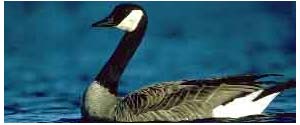| |

Swan Lake National Wildlife Refuge
Swan Lake National Wildlife Refuge was established by Executive Order 7563 on February 27, 1937. Purchase of 10,670 acres began at that time. Following purchase of land, the Civilian Conservation Corps began work on the refuge creating wetlands, constructing roads and buildings, and initiating the refuge farming program.
The primary purpose of the refuge is to provide nesting, resting, and feeding areas for waterfowl, primarily ducks. An important secondary purpose was to preserve a remnant flock of prairie chickens. Unfortunately, adequate grassland habitat to maintain a viable population of the birds was not available.
Since establishment of the refuge, the primary emphasis on waterfowl species has been expanded to include the Eastern Prairie Population of Canada geese. Canada geese were first observed using the refuge in the early 1940s, and numbers increased gradually to peak populations over 150,000 birds annually. Although these populations have steadily declined, Swan Lake is still considered a primary wintering area for Canada geese.
The refuge lies in the floodplain of the Grand River, near its confluence with the Missouri River in north-central Missouri. Flooding is common, especially during spring and summer periods. In addition to waterfowl management objectives, providing habitat for resident wildlife, protecting endangered and threatened species, encouraging biodiversity, developing shorebird habitat, and providing public opportunites for outdoor recreation and environmental education are on-going programs.
Getting There . . .
From Kansas City (about 100 miles) go north on I-35 to Route 36; east on 36 to State Route 139; south on 139 to Sumner; then south on Swan Lake Drive about 3 miles to the refuge. From Mendon, Missouri, go north on Route CC 1.5 miles to the east entrance gate of the refuge, then left into the refuge interior.
Get Google map and directions to this refuge/WMD from a specified address: |
|
|
|

The refuge is closed to the public.

Environmental Education
Fishing
Hunting
Interpretation
Photography
Wildlife Observation
Learn
More >>


Major management programs at Swan Lake National Wildlife Refuge include cropland management, water management, public use, and, to a lesser extent, grassland and forest management.
There are nearly 7,000 acres of wetlands found on the refuge. Silver Lake contains 3,050 acres of open water. Serving as the refuge's reservoir pool, water can be easily transferred by flowage ditches and water control structures from the lake to smaller but more manageable wetland units.
Moist soil management, or the production of natural waterfowl foods through water manipulation, is practiced extensively. Water management schemes are aimed at benefiting not only waterfowl, but wading birds, shorebirds, and a variety of wetland plants.
About 1,000 acres of the refuge are farmed to some degree periodically. The goals of the farming program are to meet waterfowl food objectives under the Eastern Prairie Population of Canada Geese Management Plan, provide habitat diversity for both migratory and resident wildlife, and complement other refuge management programs for the benefit of wildlife and people.
Grassland management practices include controlled burning, mowing, planting of native grass varieties, and other measures used to maintain a dynamic upland grass ecosystem. As with grasslands, existing forested tracts are managed to mimic what was here historically. Regardless of the management techniques used, each is designed to help meet the needs of various refuge plants and animals.
|
|

